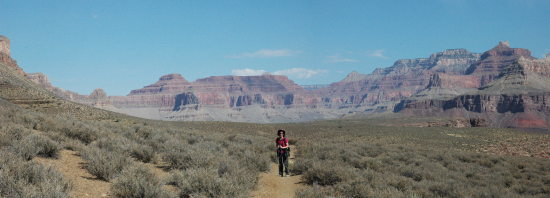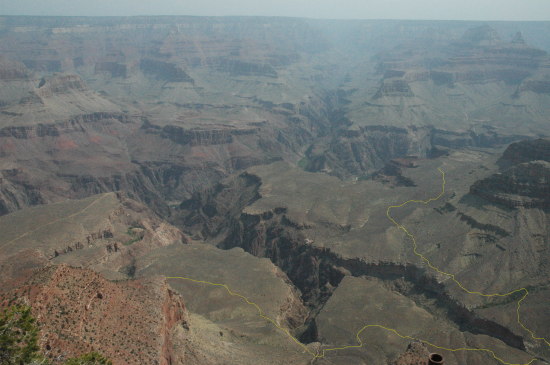Doing the Grand Canyon Right

The one thing about the Grand Canyon that attracts hikers is its intimidating nature. People feel challenged by its large size and depth, and want to prove to themselves that they can do it.
The irony of this to me is that it is that intimidating nature that generally causes most people the most problems. People worry about the climb out. They worry about the heat. They worry about the lack of water. And they worry about vastness around them.
All of these things — the climb, the heat, the lack of water, and the vastness — must be dealt with. Each has caused the death of many visitors. Each could kill you if you are not prepared. In fact, one or all of these factors are probably the primary causes behind all of the approximately 300 rescues that occur each year at the Grand Canyon.
Yet, none of these factors is actually the biggest obstacle for most people trying to climb in and out of the Canyon. Instead, it is the worry about these things that causes people the most difficulties.
Consider the heat. Whenever the temperature rises above 100 degrees people start to talk about it like it is some deadly thing that they can’t tolerate and must avoid. They worry about it so much that it begins to affect them physically. They feel it. They dwell on it continuously. And it ends up sapping them of energy and endurance.
Yet, Diane and I have been hiking in 100+ degree circumstances for years. We agree that it is not for everyone. But what we have found is that if the temperature goes up, all you have to do is drink more water, go a bit slower, and rest in the shade whenever possible. If you do these things, the heat doesn’t really matter. It won’t stop you. As a result, we don’t think about it too much. We don’t let it intimidate us.
The same applies to the climb out of the Canyon. From Bright Angel campground (at 2480 feet) the climb up on the Bright Angel trail to the south rim (at 6860 feet) is approximately 4420 feet. That’s climbing up about 84% of a mile, spread over a distance of 9.5 miles. Most people look at these numbers and worry so much about them that they become intimidated by them, to the point that many decide never to even try the hike. Of those who do, many can’t get these facts out of their mind every step up the trail. I know, because I felt that way the first few times I hiked out of the canyon. I kept thinking, “We’ve been hiking for an hour and we’ve only gained about 500 feet. This is never going to end!”
The result of these worries is that people begin to hurry their hike. They want to get to the rim and get it over with as fast as possible. They walk faster than they should. They stop to rest less than they should. And those who don’t carry hydration bladders and have to stop and remove their packs to get at their water drink less in order to waste less time.
All wrong!
The key to enjoying the Grand Canyon (as well as most hiking) is to take your time. You should never rush. In fact, one of the best pieces of advice I have ever gotten was from a ranger at Phantom Ranch. She explained that it is very easy to climb out of the Canyon. All you do is never walk so fast that you can’t hold a conversation. If you start to breath too heavily and can’t talk, you simply slow down, take smaller steps, and regain your breath. You don’t stop, however. You simply take it slower.
For example, I hike very slowly up hill. If I go too fast my heart begins to pound and I can’t get my breath and will quickly have to stop. However, if I walk steadily but very slowly I never have to stop, and can keep going for as long as I want.
It is therefore not unusual for me to be passed repeatedly by others. They zip past me but soon have to stop to rest. I meanwhile just keep on slogging away at a slow but steady pace. Soon I catch up and pass them. They get up and zip past me again, but this time don’t quite get as far ahead before they have to stop to rest. After awhile I slog past again. Up they go, zipping by, but now passing me by even less distance before stopping to rest. This repeats several times, until eventually, they can’t even catch up to me when they need to rest.
When climbing out of the canyon last week this happened again and again. I’d sooner or later suggest as I walked by that if they’d slow down they’d make better time, but almost never would anyone take this advice. In the end, they would all get left in the dust.
This rule applies just as much to issues of water and rest. It is very important to rest periodically, loosening or even removing the boots and raising the feet so that they can cool down. A five to ten minute rest like this every two hours will allow you to hike farther and faster with less exhaustion.
In other words, you will actually make better time by simply slowing down. And you will have more time to enjoy the view!
The desire to hurry I think is also why most people don’t spend any extra time at the bottom of the canyon. They get there, but are worried about the hike out. Thus, most people arrive one day and leave the next.
Diane and I however don’t want to simply leave. It takes a lot of effort to get into the Grand Canyon. We want to see some of it while we are there. In fact, I have now been to the bottom of the Grand Canyon five times. Of these the best trips were the ones in which I spent some time in the canyon, doing day hikes to some of the more remote places within the canyon.
On our trip last week, for example, we finally did a day hike I have been wanting to do for more than twenty years. From Phantom Ranch we hiked up the South Kaibab trail out of the 1,000 foot deep Inner Gorge, where flows the Colorado River, to the Tonto Plateau, which is that large flat area on each side of the Inner Gorge. From here we took the Tonto trail across the Tonto Plateau, heading west to the Bright Angel trail and the Indian Gardens campground. From there we went back down into the Inner Gorge on the Bright Angel trail. Overall, the hike was about 13 miles, with about a 1000 feet of elevation gain. The picture below looks down at this area of the Tonto Plateau, with the Tonto trail indicated by the thin yellow line.

This is not actually a very difficult hike. Back east it is not unusual for hikes to be a dozen miles long with that much or more elevation change. And in the west, most hikes usually have at least that much elevation gain, if not two to three times more.
Yet, despite the hundreds of hikers who arrive at the Colorado River each day during the busy season, almost no one ever does this. They are intimidated. Nor do National Park Service rangers help much. I once asked a ranger for some details about hiking on the Tonto trail, and her answer was a blunt, “Don’t do that. You will risk death if you hike on the Tonto.”
What a shame. The picture at the top of this story is of Diane standing on the Tonto Plateau during this hike. From this trail we got a real feeling of the size and majesty of the Grand Canyon. From this trail we were in the canyon, not above it looking down or in the Inner Gorge at the Colorado River, where you can’t see very much around you. Here, we could see everything, and it told us how big and grand the Grand Canyon truly is.
The bottom line for everything I have been saying is that you should go out and do these things. Don’t take no for an answer. Find out what you need to know, do it wisely, but do it. The reward will be immeasurable.
On Christmas Eve 1968 three Americans became the first humans to visit another world. What they did to celebrate was unexpected and profound, and will be remembered throughout all human history. Genesis: the Story of Apollo 8, Robert Zimmerman's classic history of humanity's first journey to another world, tells that story, and it is now available as both an ebook and an audiobook, both with a foreword by Valerie Anders and a new introduction by Robert Zimmerman.
The ebook is available everywhere for $5.99 (before discount) at amazon, or direct from my ebook publisher, ebookit. If you buy it from ebookit you don't support the big tech companies and the author gets a bigger cut much sooner.
The audiobook is also available at all these vendors, and is also free with a 30-day trial membership to Audible.
"Not simply about one mission, [Genesis] is also the history of America's quest for the moon... Zimmerman has done a masterful job of tying disparate events together into a solid account of one of America's greatest human triumphs."--San Antonio Express-News


Robert, I have a pretty good idea of how old you are, were(no offense intended) there many people past your age doing this, and do people do these extended hikes solo? This is on my bucket list, but there is no way my spouse could do this.
I turned 60 in February. And yes, there were people my age and older on the trail. I don’t know how old you are, but I would strongly advise that if you want to do it, do some hiking beforehand to get some experience and training. The experience acts like the simulations the astronauts do. It teaches you that you can do it, and calms you down so you won’t be intimidated. The training makes it easier to do everything.
As for hiking solo, I generally would not recommend it. However, I don’t think it is a problem at all at the Grand Canyon. You will never really be alone on the two main trails down to the Colorado (South Kaibab and Bright Angel). And you can very easily make friends as you go.
I am 53, I have spent my entire adult life up and down ladders repairing reefers, I know that going solo may be a no no and they say not to swim solo, but I am physically up to such a trip, thanks for the response and I am glad you had a good time!
As I am sure you can guess by now, I would say you should do it. You will not be solo if you take the main south rim trails. Also, stay at Phantom Ranch. That way, you won’t have to bring sleeping bag, tent, and pad. They provide the bed and blankets and the dorms and cabins are air conditioned. Plus, eat at the Phantom Ranch cantina. The food is good.
Thankyou much!
Looks like fun.